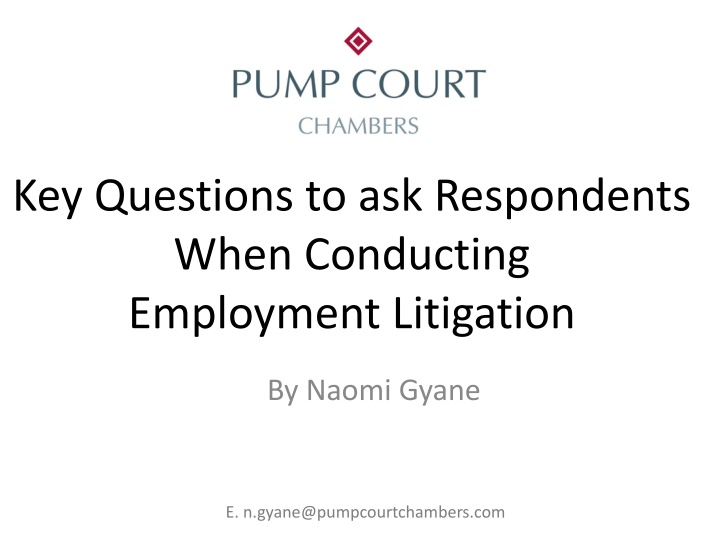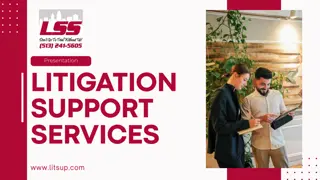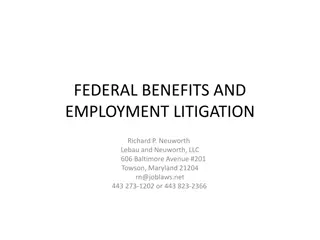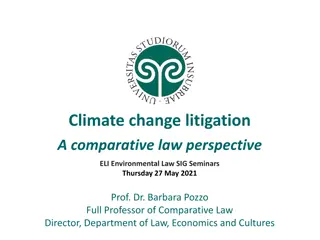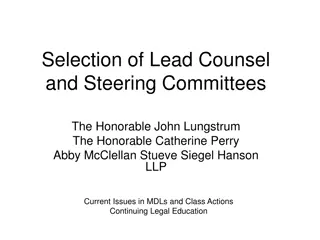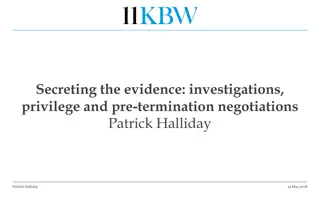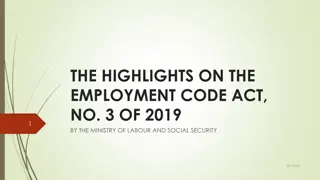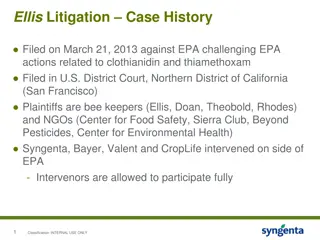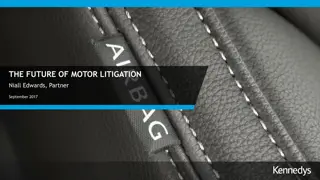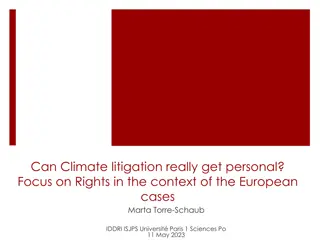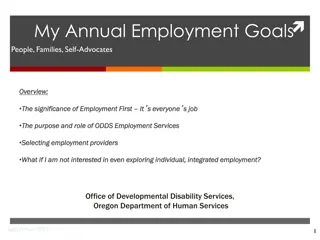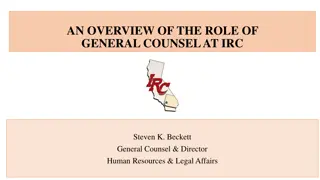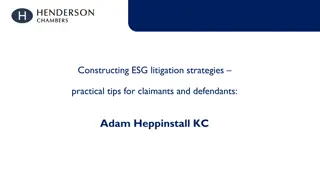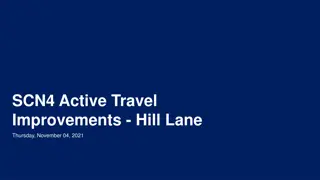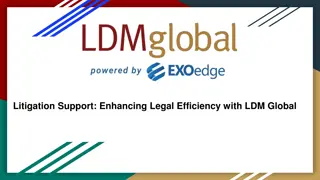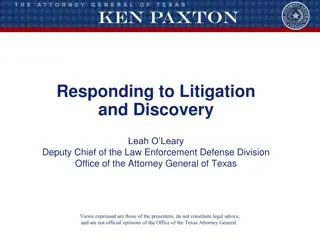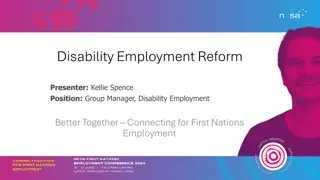Key Questions for Employment Litigation Respondents
Naomi Gyane provides key questions to ask respondents during employment litigation, focusing on jurisdiction, documentation requests, and clarifying important details. The content also delves into the significance of the ACAS EC Certificate and its role in the tribunal process.
Download Presentation

Please find below an Image/Link to download the presentation.
The content on the website is provided AS IS for your information and personal use only. It may not be sold, licensed, or shared on other websites without obtaining consent from the author.If you encounter any issues during the download, it is possible that the publisher has removed the file from their server.
You are allowed to download the files provided on this website for personal or commercial use, subject to the condition that they are used lawfully. All files are the property of their respective owners.
The content on the website is provided AS IS for your information and personal use only. It may not be sold, licensed, or shared on other websites without obtaining consent from the author.
E N D
Presentation Transcript
Key Questions to ask Respondents When Conducting Employment Litigation By Naomi Gyane E. n.gyane@pumpcourtchambers.com
Employment Tribunal Jurisdiction 1. Please can I have a copy of the ACAS EC Certificate 2. Please can I have a copy of the Contract of Employment? 3. Are the dates of employment and/or alleged incidents correct?
(1) Please can I have a copy of the ACAS EC Certificate Rejection of a Claim due to Substantive Defects Rule 12(1)(c) (f) of the Employment Tribunals Rules of Procedure 2013 (as amended) Sainsbury's Supermarkets Ltd v Clark and others [2023] EWCA Civ 386
(1) Please can I have a copy of the ACAS EC Certificate Rule 12. (1) The staff of the tribunal office shall refer a claim form to an Employment Judge if they consider that the claim, or part of it, may be (a) one which the Tribunal has no jurisdiction to consider; (b) in a form which cannot sensibly be responded to or is otherwise an abuse of the process; (c) [one which institutes relevant proceedings and is made on a claim form that does not contain either an early conciliation number or confirmation that one of the early conciliation exemptions applies; (d) one which institutes relevant proceedings, is made on a claim form which contains confirmation that one of the early conciliation exemptions applies, and an early conciliation exemption does not apply; (da) one which institutes relevant proceedings and the early conciliation number on the claim form is not the same as the early conciliation number on the early conciliation certificate; (e) one which institutes relevant proceedings and the name of the claimant on the claim form is not the same as the name of the prospective claimant on the early conciliation certificate to which the early conciliation number relates; or (f) one which institutes relevant proceedings and the name of the respondent on the claim form is not the same as the name of the prospective respondent on the early conciliation certificate to which the early conciliation number relates.
(1) Please can I have a copy of the ACAS EC Certificate In Sainsbury's Supermarkets Ltd v Clark and others [2023] EWCA Civ 386, the Court of Appeal held that if a claim is not rejected by the tribunal, it is not open to the respondent to argue at a later stage that it should have been rejected. The time for rejection of the claim has passed. The respondent's remedy will be to raise any points about non-compliance with the ET rules in their form ET3 and to seek dismissal of the claim under rule 27, or in appropriate cases at a later stage to apply for the claim to be struck out under rule 37.
(2) Please can I have a copy of the Employment Contract No contract may mean not an employee for the purposes of bringing an Unfair Dismissal Claim under the Employment Rights Act 1996; No contract may mean not a worker and therefore the Tribunal may not have jurisdiction to hear any claim under the Employment Rights Act 1996 and/or some claims within the Equality Act 2010 No Contract may instead mean a breach of Section 1 of the Employment Rights Act 1996 and further remedy under Section 38 Employment Act 2002
(3) Are the dates of employment and/or alleged incidents correct? Pursuant to Section 108(1) of the Employment Rights Act 1996 an employee must have at least two years service on the effective date of termination in order to bring an unfair dismissal claim (not required if the dismissal is alleged to be automatically unfair) Pursuant to Section 123 of the Equality Act 2010 and Section 111 of the Employment Rights Act 1996, unless an extension is granted, a Tribunal only has jurisdiction to consider complaints presented before the end of the period of three months beginning with the last act complained about (Equality Act 2010) or effective date of termination (Employment Rights Act 1996)
Evidence gathering Who made the decision or carried out the treatment complained about by the individual? Can I have a copy of the Resignation letter or Dismissal letter or Letter setting out Redundancy rationale Can I have a copy of the emails referred to by the individual in which they complain about the issue? Who within the organisation (if any) knew about the individual s disability? Has there already been any investigation into the allegations set out in the pleadings? If so, can I have a copy of the investigation material? Do you undertake E&D training; collate statistical data on equal pay; or diversity or on recruitment in relation to protected characteristics?
Drafting Grounds of Resistance 1. Please can I have a copy of the Claimant s last three payslips 2. Does the Claimant owe you any money? 3. Using the evidence gathered
(1) Please can I have a copy of the Claimants last three payslips Holiday Pay Claims: Harpur Trust v Brazel [2022] UKSC 21 Check the Holiday pay is correct Provided a worker remains under contract, they have an entitlement to 5.6 weeks' holiday in each full leave year, regardless of the amount of work done. In Harpur Trust v Brazel [2022] UKSC 21 the Supreme Court held that the 5.6 weeks' annual leave entitlement under the WTR 1998 should not be reduced pro rata for "part-year workers" (those who are employed for the whole year but only work some weeks and not others). The case has led to difficulty in the calculation of holiday for part-year workers, casual workers, agency workers and others with irregular or unpredictable working patterns. In the past, many employers have given such workers a paid holiday entitlement equivalent to 12.07% of hours worked. (This figure is derived from the fact that 12.07% is 5.6 46.4, where 5.6 is the statutory annual leave entitlement and 46.4 is the number of working weeks in a year after statutory annual leave is deducted). However, as Brazel has shown, for workers with non-standard working patterns (such as casual workers and part-year workers), this method is not compliant with the WTR 1998. The decision has led to a situation where some workers receive proportionately more paid holiday, relative to the hours they work, than others. For example, if A works 40 hours every other week they will perform half as much work in a year as B who works 40 hours every week. However, according to Brazel, both A and B will have the same entitlement to holiday and holiday pay. Similarly, if C works 20 hours every week, they will perform the same amount of work as A, but only receive half as much holiday pay. Notice pay: Check the correct notice has been paid Check the pay asserted by the Claimant in the ET1 is accurate
(2) Does the Claimant owe you any money? The Respondent has a right to make a counterclaim in cases in which a former employee brings a breach of contract claim against them e.g. wrongful dismissal; breach of contract re. bonus (Article 4(d) Extension of Jurisdiction Order 1994) In Ridge v HM Land Registry UKEAT/0485/12 the EAT confirmed that the defence of set-off is available in contract claims in the employment tribunal.
(3) Using the evidence gathered (1) Who made the decision or carried out the treatment complained about by the individual? InBennett v Mitac Europe Ltd EA-2020-000349-LA, the EAT held that a tribunal had erred in its analysis of whether Mitac had discharged the burden of proof to establish that Mr Bennett had not been subjected to direct discrimination because of his manager's disability. Mr Bennett had been dismissed and Mitac did not call the manager who made the dismissal decision to give evidence. The EAT set out nine important points to note from the authorities on what happens once the burden of proof has shifted to the respondent to establish that discrimination has not occurred: The standard of proof necessary to discharge the burden is the balance of probabilities. That is not altered by the reference to the requirement to establish that the treatment was "in no sense whatsoever" because of the protected characteristic. That requirement relates to the extent to which the protected characteristic need have been a cause of the treatment; it need only have been a material cause (the point made in Nagarajan v London Regional Transport [1999] IRLR 572 (HL)). Similarly, the general requirement for "cogent evidence" to discharge the burden does not apply a standard of proof beyond that of the balance of probabilities. Nonetheless, it is an important point. It is the respondent that generally can provide evidence about the reason for the claimant's treatment. The shifting burden of proof was designed to assist claimants in discrimination claims because such claims generally require an analysis of the reasoning process of an employee, or employees of the respondent. The respondent will be able to choose what evidence to call about the decision-making process and it is likely to be the key evidence in deciding whether discrimination has occurred. While documentary evidence is likely to be important, because express evidence of discrimination is rarely available, much is likely to turn on the evidence of the decision maker(s). An important consequence of section 136 of the EqA 2010 is that if the respondent chooses not to call the relevant decision maker it puts itself at considerable risk of an adverse finding, should there be sufficient evidence to shift the burden of proof, because it will face substantial difficulty in discharging the burden. The requirement for "cogent" evidence to discharge the burden should not be disregarded. It is guidance from the Court of Appeal, approved by the Supreme Court. The fact that a decision taker is not called to give evidence does not necessarily mean that the required cogent evidence cannot be provided. There may be compelling documentary evidence or others might be able to give convincing evidence that they know the reason why the decision was taken. However, there should be a reasoned analysis of such evidence. It will usually be necessary to consider why a decision maker was not called to give evidence. There may be a compelling reason, for example, a witness could be unwell or have died. Distance should not be assumed to be an insurmountable barrier to a witness giving evidence because an application can be made for a witness to give evidence by video. Where no reason or an unconvincing reason is given for the absence of the decision maker, particularly careful analysis is required of the evidence to determine whether, on balance of probabilities, it is sufficiently cogent to prove that the protected characteristic was not a material factor in the decision taken. On occasions parties choose not to call a witness because if the witness was called it is likely that their evidence would be damaging. That possibility should be borne in mind, particularly where the respondent is reticent to explain why a decision maker is not giving evidence. As the protected characteristic need only be a material factor in the making of the impugned decision, the fact that there is evidence that some other factor was the primary reason for the treatment complained of does not exclude the possibility that the protected characteristic was a factor in the treatment.
(3) Using the evidence gathered cont/ (1) Copies of documentation (1) Enables you to cross-reference oral instructions (2) Knowledge (1) In cases such as where a Protected act, Disability discrimination, or a Protected Disclosure is alleged knowledge is paramount. Where an Employer asserts they did not have knowledge of an act of protected characteristic or protected disclosure it is a crucial assertion to make in any defence (3) Previous investigations (1) Enables you to draft your Defence consistent with the previous explanations and/or address any inaccuracies or inconsistencies with subsequent instructions (4) Statistics & training (1) Section 136(2) of the Equality Act 2010 states, if there are facts from which the court could decide, in the absence of any other explanation, that a person (A) contravened the provision concerned, the court must hold that the contravention occurred. (2) In discrimination cases, statistics provide a helpful snapshot of the Company diversity and may indicate a non- discriminatory work environment providing cogency to a non-discriminatory explanation advanced. (3) Similarly, where comprehensive and regular training occurs relating to equality and diversity, this can form the basis of a reasonable steps defence pursuant to Section 109(4) of the Equality Act 2010
Solicitors Code of Conduct 1. Are you happy that I represent both you and an individually named employee party?
(1) Are you happy that I represent both you and an individually named employee party? Solicitors' Code of Conduct In deciding how to deal with potential conflicts of interest, solicitors regulated by the SRA should consider theSRA Standards and Regulations, particularly paragraphs 6.2 and 6.5 of the Code of Conduct for Firms, and paragraphs 6.2 and 6.5 of the Code of Conduct for Solicitors, RELs and RFLs(which are in identical terms). There is a separate regulatory regime applicable in Scotland. The Code says that where there is a conflict of interest, or a significant risk of conflict, the same firm or solicitor can only act in certain situations, one of which is that the clients have a "substantially common interest" in the matter. According to the SRA's glossary, this means that there must be a clear common purpose between the clients in relation to any matter or a particular aspect of it and a strong consensus on how it is to be achieved.. In such situations, the solicitor may act for more than one client, but only if the following are satisfied: The clients give informed consent, either in writing or evidenced in writing. Where appropriate, the solicitor puts in place effective safeguards to protect each client's confidential information. The solicitor is satisfied that it is reasonable for them to act for all the clients: TheGuidance on Conflicts of Interest, which supplements the Code of Conduct, sets out some possible factors to consider when deciding whether it is reasonable to act. These include the respective knowledge and bargaining power of the clients, the extent to which there may need to be negotiation between them on unresolved issues, the benefits (in terms of speed, convenience or cost) of joint representation, and the risk of inappropriate transmission of confidential information. The overriding consideration as expressed in Principle 7 of the SRA Principlesis that a solicitor must "act in the best interests of each client". The Law Society's practice note on Conflict of interestsmay also be useful.
Employment Tribunal Procedure 1. Does our evidence include information/ evidence about employees that is of a sensitive nature / sexual nature 2. Are our witnesses still employed 3. Are any witnesses giving evidence from abroad?
(1) Does our evidence include information/ evidence about employees including the individual of a sensitive nature / sexual nature Rule 50 of The Employment Tribunals Rules of Procedure 2013 (as amended) Privacy and restrictions on disclosure Rule 50. (1) A Tribunal may at any stage of the proceedings, on its own initiative or on application, make an order with a view to preventing or restricting the public disclosure of any aspect of those proceedings so far as it considers necessary in the interests of justice or in order to protect the Convention rights of any person or in the circumstances identified in section 10A of the Employment Tribunals Act. (2) In considering whether to make an order under this rule, the Tribunal shall give full weight to the principle of open justice and to the Convention right to freedom of expression. (3) Such orders may include (a) an order that a hearing that would otherwise be in public be conducted, in whole or in part, in private; (b) an order that the identities of specified parties, witnesses or other persons referred to in the proceedings should not be disclosed to the public, by the use of anonymisation or otherwise, whether in the course of any hearing or in its listing or in any documents entered on the Register or otherwise forming part of the public record; (c) an order for measures preventing witnesses at a public hearing being identifiable by members of the public; (d) a restricted reporting order within the terms of section 11 or 12 of the Employment Tribunals Act. (4) Any party, or other person with a legitimate interest, who has not had a reasonable opportunity to make representations before an order under this rule is made may apply to the Tribunal in writing for the order to be revoked or discharged, either on the basis of written representations or, if requested, at a hearing. (5)Where an order is made under paragraph(3)(d) above (a)It shall specify the person whose identity is protected; and may specify particular matters of which publication is prohibited as likely to lead to that person s identification; (b)it shall specify the duration of the order; (c) the Tribunal shall ensure that a notice of the fact that such an order has been made in relation to those proceedings is displayed on the notice board of the Tribunal with any list of the proceedings taking place before the Tribunal, and on the door of the room in which the proceedings affected by the order are taking place; and (d) the Tribunal may order that it applies also to any other proceedings being heard as part of the same hearing. (6) Convention rights has the meaning given to it in section 1 of the Human Rights Act 1998(a).
(1) Are our witnesses still employed Wisniewski (A Minor) v Central Manchester Health Authority [1998] EWCA Civ 596 was seen as the principal authority on the question of when a court might draw adverse inferences from the absence of a witness. In Wisniewski, Brooke LJ considered the relevant authorities and derived the following principles: In certain circumstances, a court may be entitled to draw adverse inferences from the absence or silence of a witness who might be expected to have material evidence to give on an issue in an action. If a court is willing to draw such inferences, they may go to strengthen the evidence adduced on that issue by the other party or to weaken the evidence, if any, adduced by the party who might reasonably have been expected to call the witness. There must, however, have been some evidence, however weak, adduced by the former on the matter in question before the court is entitled to draw the desired inference. In other words, there must be a case to answer on that issue. If the reason for the witness's absence or silence satisfies the court, then no such adverse inference may be drawn. If there is some credible explanation given, even if it is not wholly satisfactory, the potentially detrimental effect of the witness's absence or silence may be reduced or nullified. However, more recently, the courts have been keen to emphasise that Wisniewski does not remove their discretion. For example, the Court of Appeal in Manzi v King's College Hospital NHS Foundation Trust [2018] EWCA Civ 1882 emphasised that Wisniewski "is not authority for the proposition that there is an obligation to draw an adverse inference where the four principles are engaged"; and added that there is merely a discretion to do so. There may be other matters, such as proportionality, that give rise to a valid reason for a witness's absence.
(1) Are our witnesses still employed cont./ In Efobi v Royal Mail Group Ltd [2021] UKSC 33, Lord Leggatt said: "The question of whether an adverse inference may be drawn from the absence of a witness is sometimes treated as a matter governed by legal criteria, for which the decision of the Court of Appeal in [Wisniewski] is often cited as authority. Without intending to disparage the sensible statements made in that case, I think there is a risk of making overly legal and technical what really is or ought to be just a matter of ordinary rationality. So far as possible, tribunals should be free to draw, or to decline to draw, inferences from the facts of the case before them using their common sense without the need to consult law books when doing so. Whether any positive significance should be attached to the fact that a person has not given evidence depends entirely on the context and particular circumstances. Relevant considerations will naturally include such matters as whether the witness was available to give evidence, what relevant evidence it is reasonable to expect that the witness would have been able to give, what other relevant evidence there was bearing on the point(s) on which the witness could potentially have given relevant evidence, and the significance of those points in the context of the case as a whole. All these matters are inter-related and how these and any other relevant considerations should be assessed cannot be encapsulated in a set of legal rules." (paragraph 41)
(3) Are any witnesses giving evidence from abroad? Requirement to attend to give evidence Rule 32. The Tribunal may order any person in Great Britain to attend a hearing to give evidence, produce documents, or produce information. [Where an order is made under this rule, the Tribunal shall notify the parties in writing that the order has been made, and the name of the person required to attend the hearing.](b) Evidence from other EU Member States 33. The Tribunal may use the procedures for obtaining evidence prescribed in Council Regulation (EC) No 1206/2001 of 28 May 2001(a) on cooperation between the courts of the Member States in the taking of evidence in civil or commercial matters(b).
(3) Are any witnesses giving evidence from abroad? In Agbabiaka (evidence from abroad; Nare guidance) [2021] UKUT 286 (IAC) the principle was stated as follows: There has long been an understanding among Nation States that one State should not seek to exercise the powers of its courts within the territory of another, without having the permission of that other State to do so. Any breach of that understanding by a court or tribunal in the United Kingdom risks damaging this country's diplomatic relations with other States and is, thus, contrary to the public interest Whenever the issue arises in a tribunal about the taking of evidence from outside the United Kingdom what the Tribunal needs to know is whether it may take such evidence without damaging the United Kingdom's diplomatic relationship with the other country it is not for this (or any other) tribunal to form its own view of what may, or may not, damage the United Kingdom's relations with a foreign State. In August 2022, Presidential Guidance was issued setting out the process of relying on the evidence of witnesses abroad. It states: Permission to rely on evidence from abroad will only be given where: (a) The country in which the witness is situated does not object; (b) The Tribunal then decides, in its discretion, also to give permission.
(3) Are any witnesses giving evidence from abroad? cont./ In August 2023, the Foreign, Commonwealth & Development Office published its list of which overseas countries residents can give evidence from via video link. https://www.gov.uk/guidance/taking-and-giving-evidence-by-video-link-from- abroad#tribunals So far, citizens or residents of the following countries can voluntarily give evidence from that jurisdiction: Andorra Finland Lichtenstein Paraguay Antigua and Barbuda Guyana Maldives Saint Lucia Azerbaijan Hungary Mali Saint Vincent and the Grenadines Belize Iraq Mauritius United States of America Brunei Latvia New Zealand Zambia Canada Lebanon Niger Estonia Liberia Nigeria Whether a party or witness may give evidence from abroad remains at the discretion of the Tribunal, even where the country in question has no objection.
Outcomes 1. Have any Without Prejudice / Protected Conversations occurred 2. What is your preferred outcome?
QUESTIONS? Naomi Gyane E:n.gyane@pumpcourtchambers.com T: 020 7353 0711 / 01962 868 161
